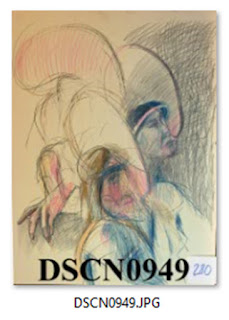180331 Bored meeting
The audience would be quite bored looking at slides and
listening to some old man droning on about his art—art he made in a bygone era,
art of questionable value. It’s an image of women wearing strange headdresses.
The people in the audience, especially those who are
twenty-something and checking their smart phones, are restless. They’re waiting
for this to end. One of them, in the back, gets up quietly and heads for the
door.
“This drawing is valued at $1,049.76,” the speaker says.
The one in the back hesitates and turns to look again. A
thousand-forty-nine?
“The colored pencil drawing measures 24-by-18 inches, or 432
square inches. The most recent market value of the artist’s work is $2.43, therefore
the value is $1,049.76. It represents 432 shares in the International Print
Center & Inkubators development.”
The above is fiction, of course, and I am the speaker,
droning on about my drawing.
The drawing has a back story which may or may not interest
viewers. It’s a story about an art professor exercising his imagination and
trying to make life drawing more interesting to contemporary drawing by
emulating theater and film costumery. He fashioned headgear for the model to
wear. It was a lightweight affair made of cardboard and tinfoil. Was it
effective? Are the drawings more interesting than they would have been as
drawings of women’s heads?
Who can say? The point is, there is a back story, and the
drawing is the only testimony that it ever happened. The reproduction above, a
hasty snapshot made in my gallery by my wife and daughter, is testimony that it
exists, and proof that there was—back in 1967—such a drawing session. That
there is a digital file now, poor as it is in terms of production quality, is a
step toward validating its existence, its authenticity as an original work in
the world of original drawing from live models.
Enhanced as it was by the head gear is a small indication of
the artist’s intent toward making the drawing a better work of art by adding a
narrative element.
Most important of all, the action continues from the day in
1967 that it was made, in the idealism and optimism that art exists at all persists
in that it can be repeated in digital form. I am thinking of Robert
Rauschenberg’s observation regarding repetition of works of art—that unless the
work is repeated again and again, the art work doesn’t exist at all. There is a
language of art, he said, and to understand the language it must be repeated.

No comments:
Post a Comment